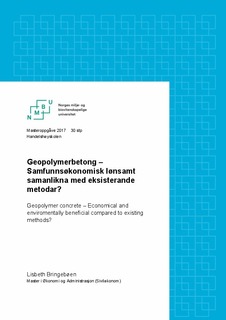| dc.contributor.advisor | Rosendahl, Knut Einar | |
| dc.contributor.author | Bringebøen, LIsbeth Johanna | |
| dc.date.accessioned | 2017-06-12T08:28:48Z | |
| dc.date.available | 2017-06-12T08:28:48Z | |
| dc.date.issued | 2017 | |
| dc.identifier.uri | http://hdl.handle.net/11250/2445739 | |
| dc.description.abstract | Dette er ei nytte-kostnadsanalyse av prosjektet til Carbo Lucra (CL) om å produsere geopolymerbetong. Konklusjonen syner at geopolymerbetong er samfunnsøkonomisk lønsamt.
Geopolymerbetong kan nyttast til det same som tradisjonell portland sement betong, men er likevel enno ikkje kommersialisert. Geopolymerbetongen er laga av avgangsmassar frå gruvedrift og flygeoske, og er dermed eit innovativt og miljøvenleg byggemateriale. Idèen til CL har berre 38 prosent av karbonavtrykket til tradisjonell betong, altså har tradisjonell betong 2,6 gonger så høgt CO2-utslepp som geopolymerbetong. Om geopolymerbetong kan fraktast til forbrukar som bindelmiddel i staden for som ferdig betong, vil tradisjonell betong ha 3,6 gonger så høgt CO2-utslepp.
Ein kostnadseffektiv gjennomføring av utsleppsreduksjon for å nå togradersmålet vil kunne nåast dersom verda prøver å ha same samfunnsøkonomiske marginalkostnad ved alle utsleppskjelder. Ved å nytte CO2-prisen for togradersmålet i år 2030, så vil bruk av kun geopolymerbetong gje ei reduksjon på 677 mill kr samanlikna med Portland sement betong. Om geopolymerbetong kan fraktast til forbrukar som bindemiddel, gjev det ei reduksjon på heile 790 mill kr.
For vanleg betong er det knytt utgifter både til klinker og tilslag. Totalpris for deponering av flygeoske er kr 5,25 millardar for mengde tilsvarande norsk forbruk av betong. Dette er den samfunnsøkonomiske gevinsten ved å heller å bruke avfallet som input til geopolymerbetong. Milljødepartementet som har godkjent deponisøknaden til Nordic Mining ASA, har ikkje sett verdi på tapet av å legge avgangsmassane i Førdefjorden. Effekt som reduserte mogelegheiter for fiskeoppdrett og tradisjonelt fiske, reduserte bestandar av vill-laks og tap av rekreasjonsverdiar kan verdsetjast økonomisk. Det er utilstrekkeleg berre å slå fast at miljøulempene vert vegne opp av inntektene utan å grunngje påstanden. At verdsetting av tenester er vanskelig å anslå, bidrar truleg til at verdien av for eksempel urørd natur og biologisk mangfald vert undervurdert.
Reduksjon av C02 utslepp er ei av dei viktigaste oppgåvene i vår tid. | nb_NO |
| dc.description.abstract | This report analyses the cost-benefit of the use of geopolymer concrete, which is the idea of the company Carbo Lucra (CL). The analysis concludes that use of geopolymer concrete is economically and environmentally beneficial.
The application of geopolymer concrete is the same as portland cement concrete. However, geopolymer concrete material has not yet been popularly used for various applications. Geopolymer concrete is made from utilization of waste materials such as fly-ash and slag, and is therefore an innovative and eco-friendly construction material. The carbon footprint of the idea of CL is only 38 percent compared to portland cement concrete, meaning there is 2.6 times high CO2-emissions in favour of geopolymer concrete. If it is possible to transport only binding material instead of concrete, the carbon footprint of Portland cement will be as much as 3.6 times as high.
A cost-effective implementation of reduction of carbon emissions to reach the twodegree
goal will be within reach if the world tries to unite with the same marginal cost at all sources of CO2 emissions. By using the CO2-price for reaching the twodegree goal in the year 2030, the use of geopolymer concrete provides a reduction of NOK 677 millions compared to Portland cement concrete. If the geopolymer can be transported as binding material, it will provide a reduction of NOK 790 mill.
The expense of production of Portland concrete is due to clinker and aggregates. In geopolymer concrete however, both bindings and aggregates will be based on raw material that elsewise would be put in a landfill, and the cost of this will instead be transferred as income to CL. Total expenses for landfill of fly ash is NOK 5,25 billions for total amount of raw materials. This is economical- and environmentally gains for using the raw material rather than putting it in landfill.
Even though the Norwegian department of environment approved the application from Nordic Mining ASA, they have not set a price on the loss of the environment in the fjord due to using the fjord as dumping grounds. Effects such as reduced opportunities for fish-breeding and traditional fishing, reduced amounts of wild salmon and the loss of values of recreation is possible to treasure economically. It is not enough to conclude that the environmentally disadvantage will be outweighed by the income without any reasoning. It is difficult to put a price on nature, something that leads to untouched nature probably being underestimated economically.
Reduction of CO2-emissions is among our worlds most important tasks. | nb_NO |
| dc.language.iso | nno | nb_NO |
| dc.publisher | Norwegian University of Life Sciences, Ås | nb_NO |
| dc.rights | Attribution-NonCommercial-NoDerivatives 4.0 Internasjonal | * |
| dc.rights.uri | http://creativecommons.org/licenses/by-nc-nd/4.0/deed.no | * |
| dc.title | Geopolymerbetong : samfunnsøkonomisk lønsamt samanlikna med eksisterande metodar? | nb_NO |
| dc.title.alternative | Geopolymer concrete : economical and enviromentally beneficial compared to existing methods? | nb_NO |
| dc.type | Master thesis | nb_NO |
| dc.subject.nsi | VDP::Samfunnsvitenskap: 200::Økonomi: 210 | nb_NO |
| dc.description.localcode | M-ØA | nb_NO |

